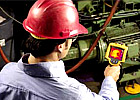

Technologies & Applications > Cost effective Thermal Imaging
Cost effective Thermal Imaging
Building maintenance industry warms to infra-red measurement

In principle, thermal imaging technology (“thermography”) can be used wherever there’s a temperature variation. In practice though, the cost and complexity of the necessary equipment has tended to limit its use to a few specialise areas where a relatively high investment in equipment and training could be justified - until now.
With recent advances in technology from companies such as Fluke and Testo , thermography has begun to be used much more widely in test and measurement operations. New application areas are emerging fast. In building maintenance for example, thermography is the perfect tool for analysing the thermal efficiency of a building. Until quite recently, energy audits using thermographic techniques were prohibitively expensive for most, and those who could afford it tended to contract the process out to a specialist. Facilities engineers can now think differently - equipment costs have tumbled and the learning curve for a wide range of tasks is short and hassle-free. Today, thermography is not only viable, but extremely cost-effective for a range of industries and applications. Investing in thermographic equipment, with appropriate training, delivers fast return on investment by enabling in-house audits to meet ongoing efficiency regulations.
Of course, while thermography has become simpler and less expensive, some knowledge is still necessary to choose the appropriate product. If, for example, you’re just looking for hotspots in electrical and mechanical equipment, you only need enough resolution to compare one image with another - so an entry-level product is likely to be sufficient for your needs. Alternatively, if you need a detailed thermal “map” of an area, showing fine graduations in temperature, you need a more advanced product with higher resolution (essentially, each pixel records a temperature at that point on the image - and pixels cost money). Other products have even more advanced functions; Fluke for example offer Thermal Imagers that allow thermographers to view a thermal image at the same time as an optical image, which is an extremely powerful tool.
Calibration is also a necessary consideration in thermography. To be sure that your equipment is measuring what it says it is, it’s important to have it calibrated against defined and agreed standards. This is important but also a straightforward issue - RS Components offers a fast and inexpensive calibration service which ensures your equipment literally measures up.
Thermography is now accessible and adaptable for a wide range of test and measurement procedures. If you want to know more about how it could benefit you, our experts can advise you. And, if you’re looking for equipment - there’s no better place to source your thermographic needs than RS Components.
